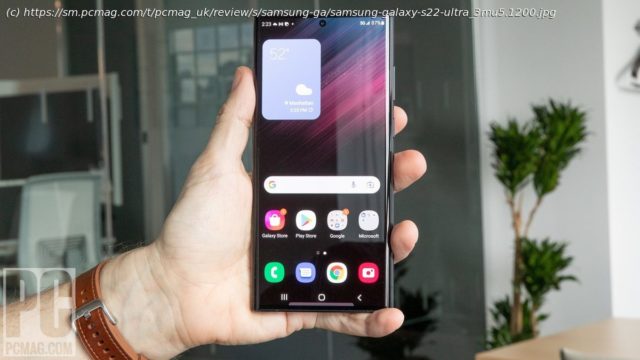A Galaxy Note by any other name
The Galaxy Note is back in a big way, even if not by name. Samsung’s Galaxy S22 Ultra (starting at $1,199.99) exhibits all the hallmark features of the Note lineup, with a big build, powerful hardware, long battery life, and, of course, a built-in S Pen stylus. The new model performs better than the Samsung Galaxy S21 Ultra from last year, as well as the Galaxy Note 20 Ultra (albeit slightly), and is an excellent choice if you want the most phone possible. That said, of the three Galaxy S22 models, the S22+ gets our top recommendation for delivering most of the same features as the Ultra at a lower price and in a more reasonably sized design. Big Body Loses the Curves The Galaxy S22 Ultra is available in several configurations, including 8GB RAM with 128GB storage ($1,199.99), or 12GB RAM with either 256GB ($1,299.99),512GB ($1,399.99), or 1TB of storage ($1,599.99). Note that the 1TB model appears to be a Best Buy exclusive. The phone comes in matte black, burgundy, green, or white. Left to right: Galaxy S22+ (left), Galaxy S22 Ultra (right) Despite its name, the Galaxy S22 Ultra takes its design cues from the Galaxy Note lineup. Whereas devices in the Galaxy S series have softer curves, Galaxy Note models typically sport squared-off top and bottom edges with curved, waterfall sides. At 6.43 by 3.07 by 0.35 inches (HWD) and 8.08 ounces, the S22 Ultra is wider than the 2.98-inch S21 Ultra (to accommodate the S pen), but it weighs the same. The Galaxy Note 20 Ultra and Galaxy S21 Ultra both feature camera bumps on the back that house all of their lenses. The Galaxy S22 Ultra, on the other hand, opts for a bunch of sharp-edged lenses. I don’t like this change, as it feels like they’re prime to catch on or scratch things. While the phone is rated IP68 for dust and water resistance, you should invest in a case for it—after leaving the S22 Ultra in my pocket with a few other phones for several days, I already see scratches on its matte black finish. My Galaxy S20+ also scratched easily, but the Note 20 Ultra and Galaxy S21 Ultra have held up much better thus far. I’m surprised by this damage, because Samsung says it’s using a new, super-tough Gorilla Glass Victus+ here. The lines in the upper right here are scratches on the finish—something my S21 Ultra doesn’t show after a full year The S22 Ultra’s 6.8-inch screen has 3,088-by-1,440-pixel resolution, which you can reduce to 2,316 by 1,080 or even 1,544 by 720 to conserve battery. With a 1,200-nit maximum brightness rating and an algorithm that changes not only brightness but also screen contrast in sunlight, the panel is particularly suitable for outdoor use. The screen has a variable frame rate that ranges from 1Hz to 120Hz to save battery life. You can manually set it to 60Hz, but the adaptive mode should be just as effective at reducing the refresh rate when possible. For comparison, the Galaxy S22 and S22+ models have 48Hz to 120Hz screens. As I discuss in the battery section below, that difference in minimum refresh rates likely gives the Ultra an advantage. Like the Galaxy S21 Ultra, the S22 Ultra has an ultrasonic fingerprint sensor. The S21 Ultra used Qualcomm’s 3D Sonic Sensor Gen 2, which, in regular use, is a bit inconsistent. The S22 appears to use the same hardware, but the sensor works more reliably. When I tried to unlock the phone with 10 fingertip and side-of-finger touches, I had about a 50% success rate with the S21 Ultra, while the S22 Ultra correctly detected every attempt. The phone also supports unlocking via face recognition. Ultra Connectivity The S22 is the first US phone line with Qualcomm’s X65 modem, though that hardware is likely to appear in the OnePlus 10 Pro and Apple’s iPhone 14 lineup. We tested the X65 in low-signal areas and found that it has significantly better weak-signal reception than last year’s models. Samsung frustratingly holds the official list of frequency bands that the S22 Ultra supports like a confidential state secret. The phone reconfigures itself every time you insert a SIM, and shows only the bands each carrier wants to support. However, we know that the phone supports all current 4G and 5G bands from US carriers. Samsung also confirmed to Cnet that this will be the first phone to support AT&T’s upcoming 3.45GHz band that the carrier will use to bring faster, C-band-like speeds and coverage to more of the US later this year. A millimeter-wave antenna window joins the power and volume buttons on the side of the phone There are also at least six global variants of the Galaxy S22 Ultra: The US one ends with a «U» (sold by carriers) or «U1» ( unlocked). This model has millimeter-wave 5G, as well as all the other technologies US carriers use. Samsung’s Canadian website shows a «W» model. In previous years, this version has been very similar to the US model, but without millimeter-wave 5G. I can’t yet confirm that difference in this case. The «B» model, on sale in Europe, uses the Samsung Exynos chipset and Shannon modem, according to a firmware dump on cacombos.






